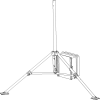
Factory installed and tested wiring by experienced technicians






Overview
The PWENC12/14 is a prewired, weather-resistant enclosure that is 12 inches wide and 14 inches tall. It starts with the same enclosure used for our ENC12/14, but then is factory configured with up to eight connectors that are attached to the data logger or peripherals within the enclosure. Sensors with the appropriate connector are simply attached to connectors on the outside of the enclosure. The PWENC12/14 includes a basic measurement program (created in ShortCut) for the -PW products sold as part of this system. If a more advanced custom data logger program is required for additional sensors, communications, control, or other needs, an extra fee will be incurred.
Benefits and Features
- Weather resistant to protect instruments
- Backplate designed so that Campbell Scientific components mount easily and securely
- Combines flexibility with ease of use
- Eliminates the task of wiring sensor leads into the data logger’s terminal strips
- White, UV-stabilized enclosure reflects solar radiation—reducing temperature gradients inside the enclosure without requiring a separate radiation shield
- Reduces wiring errors by inexperienced field technicians who are unfamiliar with the equipment
- Shortens deployment time
- Allows each enclosure in a large network to be similar to the other enclosures
- Customized options may be purchased
Technical Description
The PWENC12/14 can house one data logger, power supply, and one or more peripherals (depending on the peripheral’s footprint). You order the sensors, data logger, power supply, and communication peripherals separately. Compatible sensors, peripheral cables, and solar panels have a –PW extension.
The PWENC12/14 can be mounted to any of our tripods or towers, or to a user-supplied pipe.
Note: Refer to the Ordering Info on the web page for standard configurations. Nonstandard configurations must be special ordered. It is considered a nonstandard configuration when using a different type, size, or location for any connector, communication port, conduit, cable entry seal, or antenna bulkhead (contact Campbell Scientific for more information).
Images











Compatibility
Please note: The following shows notable compatibility information. It is not a comprehensive list of all compatible products.
Dataloggers
| Product | Compatible | Note |
|---|---|---|
| CR1000 (retired) | ||
| CR1000X (retired) | ||
| CR200X (retired) | ||
| CR216X (retired) | ||
| CR300 (retired) | ||
| CR3000 | ||
| CR310 | ||
| CR350 | ||
| CR5000 (retired) | ||
| CR6 | ||
| CR800 (retired) | ||
| CR850 (retired) | ||
| CR9000X (retired) |
Additional Compatibility Information
Peripherals
Our prewired enclosures can house any peripheral that our standard enclosures can house. Equipment that can be attached to the outside of the prewired enclosure include:
- Sensors—models with a -PW extension are compatible; a -PW version is available for most Campbell Scientific sensors.
- Digital camera—the cable used to connect a CC5MPX or CC5MPXWD high-resolution digital camera has a -PW cable termination option.
- AC wall charger—the 22110 Wall Charger (accepts 110 to 240 Vac) has the appropriate connector.
- Solar panels—Campbell Scientific offers -PW versions of our 10 W, 20 W, 50 W, and 90 W solar panels.
- Keyboard display—the CR1000KD can be connected via an optional CS I/O port.
- Laptop—an RS-232 or CS I/O port can be added to the outside of the enclosure allowing laptop connection.
- Ethernet cable—an optional Ethernet port is offered that supports communications over a local network or a dedicated Internet connection.
- Antennas—the outside of the enclosure can include connectors for attaching antenna cables.
- Measurement and control peripherals—cables used to connect our SDMs and multiplexers come in -PW versions.
Specifications
| Color | White (Reflects solar radiation, reducing temperature gradients inside the enclosure without requiring a separate radiation shield.) |
| Construction | Fiberglass-reinforced polyester enclosure with door gasket, external grounding lug, stainless-steel hinge, and lockable hasps |
| Enclosure Classification | NEMA 4X (before being modified for cable entry) |
| Dimensions |
|
| Weight | 5 kg (11.2 lb) |
Resources and Links
FAQs for
Number of FAQs related to PWENC: 11
Expand AllCollapse All
-
Yes. The sensor side of the connector is pn 22018, and the receptacle side is pn 22002.
Note: Campbell Scientific recommends that only experienced assemblers or installers use the 22018 kit. Anyone using this kit to put the connector on a cable and enclosure should have good assembly skills and the ability to make adjustments as necessary. In addition, a user-supplied product is needed to help seal up the connection (such as epoxy or heat shrink material) so that the seal will endure for its intended lifetime in the environment.
The cable connection will not have the same result as if Campbell Scientific made the connection because we use a special molding machine to complete the connector/cabling process.
-
Components can be easily replaced; however, it may be necessary to do some rewiring and system reprogramming. For assistance with rewiring and reprogramming, contact Campbell Scientific.
-
It depends on the device. Most devices have built-in mounting flanges, but some items require a separate mounting bracket.
-
-
Yes. Each enclosure Campbell Scientific sells has a powder-coated backplate with holes on 1 in. centers that match the mounting flanges on our equipment for easy mounting.
-
There is not an easy way to calculate how much desiccant is needed in an enclosure or how quickly the desiccant will need to be replaced. The following conditions affect the replacement interval:
- How much humidity the enclosure is exposed to
- The size of the enclosure
- How often the enclosure door is opened and how long the door remains open
- How airtight the enclosure is
It may be advantageous to use more than one desiccant packet at a time inside an enclosure. Campbell Scientific recommends keeping an extra supply of desiccant on hand for as-needed replacement in the enclosure.
-
The putty is shipped as part of the 7363 Enclosure Supply Kit. To order an additional 4 ounce container of electrician’s putty, specify pn 6596.
-
The following information is applicable to many of Campbell Scientific’s standard enclosures and prewired enclosures.
Note: The procedure below will not work for torn or damaged seals.
To make a field repair to a loose gasket on an enclosure, first acquire an adhesive, such as standard Gorilla Glue, that is rated for use with polyurethane foam. The adhesive should be compatible with, and recommended for, use with polyurethane foam. Follow these steps:
- Pull the gasket away from the gasket channel, being careful not to tear the gasket. The gasket does not need to be removed completely. Rather, remove only those areas that have pulled loose on their own. To keep the gasket up out of the way, lay a small object (such as a toothpick, pen, or pencil) horizontally across the channel.
- Using an adhesive that is rated for use with polyurethane foam, apply a small bead of adhesive to the gasket channel. Because the adhesive’s only function is to keep the gasket in place, use it sparingly.
- Remove any objects that were holding the gasket out of the way.
- Carefully place the gasket in the gasket channel.
- Wait 1 to 3 hours for the adhesive to cure before closing the door.
-
The desiccant should be replaced when the top colored dot on the humidity indicator card (pn 28878) turns pink; the humidity indicator card is included in the enclosure supply kit that is shipped with each enclosure. If the CS210, Enclosure Humidity Sensor, is used, replace the desiccant when the measured humidity exceeds 35%.
Privacy Policy Update
We've updated our privacy policy. Learn More
Cookie Consent
Update your cookie preferences. Update Cookie Preferences